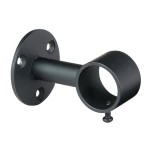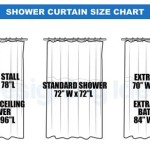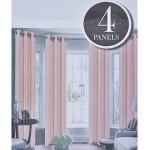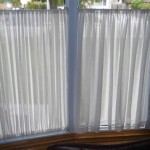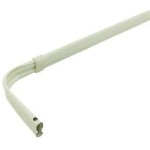What Size Curtain For a 36-Inch Window?
Selecting the appropriate curtain size for a 36-inch window involves more than simply matching the width. Achieving the desired aesthetic and functionality requires careful consideration of several factors including the curtain rod length, desired fullness, and the intended mounting height. A poorly chosen curtain size can result in a window treatment that looks inadequate or overwhelming, detracting from the overall appearance of the room.
The dimensions provided on curtain packaging typically refer to the unfolded width of a single curtain panel. This is crucial to understand when determining how many panels are required and what the final gathered width will be. Understanding the terminology and measurement principles will ensure a well-proportioned and visually appealing window treatment.
This article will explore the critical considerations for choosing the correct curtain size for a 36-inch window, providing guidance on calculating the necessary dimensions and selecting appropriate lengths and widths to achieve your desired look.
Determining Curtain Width: Fullness and Rod Length
The width of your curtains is not solely dictated by the window width. The concept of “fullness” plays a significant role. Fullness refers to the amount of fabric used relative to the width of the window. Curtains that are flat and stretched straight across the window appear stark and lack visual appeal. A more desirable look typically involves gathered or pleated curtains that provide depth and dimension.
To achieve adequate fullness, the total width of the curtain panels should be at least 1.5 to 2 times the width of the window. For a 36-inch window, this translates to a minimum curtain width of 54 inches (36 x 1.5) to 72 inches (36 x 2). This width can be achieved with a single wide panel or, more commonly, two panels each measuring between 27 and 36 inches in width. Using two panels offers flexibility, allowing them to be drawn completely open, partially open, or closed for privacy and light control.
The curtain rod length also influences the necessary curtain width. The rod should extend beyond the window frame on either side. This allows the curtains to be fully drawn open without obstructing the window, maximizing the amount of natural light entering the room. A common recommendation is to extend the rod 6 to 12 inches beyond the window frame on each side, adding 12 to 24 inches to the overall rod length. Therefore, a 36-inch window might require a rod length of 48 to 60 inches. The extra rod length needs to be factored into the total curtain width to ensure sufficient coverage when the curtains are closed.
For example, if you choose a 6-inch extension on each side, the total rod length would be 48 inches. To achieve a fullness of 1.5 times the rod length, you would need a total curtain width of 72 inches (48 x 1.5). This could be achieved with two panels, each 36 inches wide. If a greater fullness is desired (e.g., a factor of 2), then each panel would need to be 48 inches wide, resulting in a total curtain width of 96 inches. The type of curtain heading (e.g., pinch pleat, grommet, rod pocket) also affects the fullness and should be considered when making width calculations.
Determining Curtain Length: Drop and Mounting Height
The length of the curtains, often referred to as the “drop,” is determined by the desired effect and the mounting height of the curtain rod. Common curtain lengths include sill length, apron length, floor length, and puddle length. Each offers a distinct look and is suitable for different room styles and window placements.
Sill-length curtains typically end just below the windowsill. This length is often used in kitchens and bathrooms, where longer curtains might be impractical. To determine the required curtain length, measure from the top of the curtain rod to the windowsill and add a few inches for the heading. Apron-length curtains hang a few inches below the windowsill, providing a slightly more formal look than sill-length curtains. The measurement is taken similarly, extending a few inches below the windowsill.
Floor-length curtains are the most common choice for living rooms and bedrooms. They hang just above the floor, creating a clean and elegant appearance. The ideal distance from the floor is typically 1/2 to 1 inch. Measuring for floor-length curtains involves measuring from the top of the curtain rod to the floor and subtracting that small gap. This ensures that the curtains drape gracefully without pooling on the floor, which can be a tripping hazard and collect dust.
Puddle-length curtains extend several inches onto the floor, creating a romantic and luxurious effect. This style is best suited for formal living rooms or bedrooms where a dramatic look is desired. The measurement is taken from the top of the curtain rod to the floor, and then several inches are added to create the desired puddle effect. It is important to note that puddle-length curtains require more maintenance as they are more likely to accumulate dust and dirt.
The mounting height of the curtain rod significantly influences the perceived height of the room. Hanging the rod higher than the window frame can create the illusion of taller ceilings. A general guideline is to mount the rod 4 to 6 inches above the window frame. For lower ceilings, mounting the rod closer to the ceiling can maximize the perceived height. The higher the rod is mounted, the longer the curtains will need to be to achieve the desired drop. Therefore, accurately measuring the distance from the intended mounting point to the floor is essential for determining the correct curtain length.
Fabric and Heading Considerations
The choice of fabric and curtain heading also affects the final appearance and functionality of the curtains. Different fabrics have different weights and drapes, which can impact the fullness and overall aesthetic. Heavier fabrics tend to drape more elegantly and provide better insulation, while lighter fabrics allow more light to filter through and create a more airy feel.
The type of curtain heading determines how the curtains are attached to the rod and how they are gathered. Common heading styles include rod pocket, grommet, pinch pleat, and tab top. Rod pocket headings create a gathered look along the top of the curtain, while grommet headings provide a more contemporary and streamlined appearance. Pinch pleat headings offer a more formal and structured look, while tab top headings create a casual and relaxed feel.
Each heading style requires different considerations for calculating the curtain width. Rod pocket headings typically require more fabric to achieve fullness, while grommet headings tend to require less. Pinch pleat headings are often custom-made to ensure a precise and tailored fit. Tab top headings may require adjustments to the curtain length to account for the length of the tabs.
When selecting a fabric, consider its opacity and light-blocking capabilities. Sheer fabrics allow the most light to pass through, while blackout fabrics completely block out light. Semi-sheer and room-darkening fabrics offer a balance between light control and privacy. The choice of fabric depends on the intended function of the curtains and the desired level of light control.
Furthermore, the fabric's care requirements should be considered. Some fabrics require dry cleaning, while others can be machine washed. Choosing a fabric that is easy to care for can save time and effort in the long run.
In summary, determining the correct curtain size for a 36-inch window involves considering the desired fullness, curtain rod length, mounting height, fabric choice, and heading style. By carefully measuring and calculating the necessary dimensions, you can select curtains that enhance the beauty and functionality of your room.

Curtain Size Calculator The Right Can Make All Difference Design Morsels Drop Cloth Curtains

Curtain Size Calculator

Tip Tuesday How Wide Should My Curtains Be For 36 Window Design Morsels

Window Treatment Curtain Thermal Insulated Blackout Size 28 Wide X 36 Length For Kitchen Bathroom Décor Short 1 Panel Brick Pumpkin Color Top Grommet K30 Wal Com

How To Choose A Curtain Rod For Your Window Decor 10 Steps

Window Treatment Curtain Thermal Insulated Blackout Size 28 Wide X 36 Length For Kitchen Bathroom Décor Short 1 Panel Gold Color Top Grommet K30 Wal Com

Fashionable Jacquard Plaid Pleated Curtains For Kitchen Living Room Bedroom And Bathroom Rod Pocket Window Treatment Temu Switzerland

Fashionable Jacquard Plaid Pleated Curtains For Kitchen Living Room Bedroom And Bathroom Rod Pocket Window Treatment Temu Croatia

Dreaweet Green Aztec Pattern Kitchen Curtains Valance And Tiers Set Native American Style Farmhouse Window 36 Inch Length 3 Piece Tier Curtain Panels Home Office Yahoo Ping

Garden Floral Kitchen Curtain Tier And Valance Set 3 Piece Rod Pocket Short Window Curtains 36inch Length Butterfly Daisy Flower Small Treatments Tiers For Half Cafe Windows Bedroom Bathroom Wal Com


